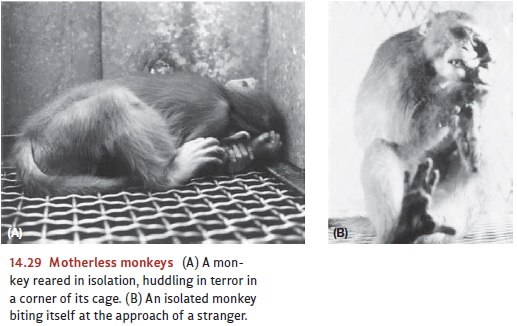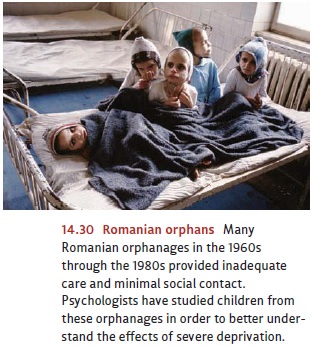Chapter: Psychology: Development
What Happens When there is No Attachment ? - Socioemotional Development in Infancy and Childhood
WHAT HAPPENS WHEN THERE IS NO ATTACHMENT ?
The
data we have considered remind us that we are a resilient species. After all,
most children cope perfectly well in childcare, even if it means they have less
contact with their parents. Most children suffer no significant problems from
divorce. But what about more severe disruption of early experience? What if
there is no attachment at all? Here the effects are dramatic and remind us that
the young of many species do not need just food and shelter, they also need
social contact.
One
source of evidence is a troubling series of experiments in which monkey infants
were reared without any social interaction. They were kept warm and safe and
had all the food and water they needed, but never saw another living creature
(Harlow, 1962; Harlow & Novak, 1973). The results were devastating. After 3
months of isolation, these animals huddled in a corner of the cage, clasped
themselves, and rocked back and forth. When they were brought together with
normally reared age-mates, rather than engaging in the playful romping that is
characteristic of monkeys at that age, the monkeys reared in isolation simply
withdrew, huddled, rocked, and bit themselves (Figure 14.29).
Modern
standards of animal care prohibit raising animals in this fashion. Sadly,
though, human children do not have the same protections—a fact documented, for
example, in the recent history of Romania. In the 1960s, dictator Nicolae
Ceausescu launched a drive to double the population of his country in one
generation. Romanian


women
were ordered to have five children each, and families too poor to rear all
these children had to relinquish them to state-run orphanages. By 1989 (when
Ceausescu was deposed and executed), the orphanages contained 150,000 children.
The orphans had received inadequate nourishment and health care and had minimal
social contact. For reasons that were unclear, the staff workers were
instructed not to interact with the children even when bringing them their bottles
(Figure 14.30).
Children
who were adopted out of this setting in the first two years of life seem to
have suffered no lasting effects of their experience. But children adopted
later showed numerous effects. For example, years later and now living with
adoptive parents, these orphans seem not to differentiate between their
(adoptive) parents and other adults and do not look to their parents for
reassurance in times of stress. The orphans also seem unable to form good
relations with their peers (Castle et al., 1999; Croft et al., 2001; O’Connor
et al., 2000; Rutter & O’Connor, 2004) and show multiple signs of impaired
cognitive development (C. A. Nelson et al., 2007; Nelson, Furtado, Fox, &
Zeanah, 2009).
Related Topics